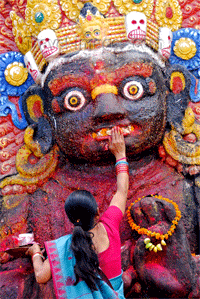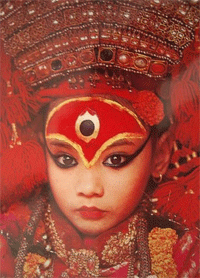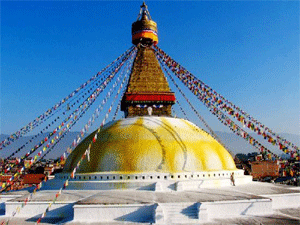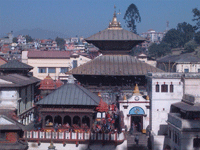
KATHMANDU
Kathmandu, capital of Nepal, accommodates 18 million people of various race, caste, creed, culture and religion and is the largest city in Nepal. The term ‘Kathmandu’ has been derived from the combinations of two Sanskrit words, ‘Kaasth’ meaning wood and ‘Mandap’ meaning beautiful shade. Situated at the elevation of approximately 4,265 ft, Kathmandu has Patan and Bhaktapur as two other cities. Since 1960s, Kathmandu has been quite popular with western tourists. Thamel, situated at the heart of the city, is a tourist hub and a favourite hang out place for Nepali youths. 130 historic monuments, temples, monasteries, palaces and other cultural heritage of Kathmandu showcase the finest display of architectural masterpiece like intricately carved windows, intrinsic roof struts, statues of gods and goddesses, temples designed in pagoda style with erotic carvings and repoussé metalwork facades. UNESCO World Heritage Sites has declared Durbar Squares of Hanuman Dhoka, Patan, Bhaktapur, the Buddhist stupas of Swayambhu and Boudhnath, and the Hindu temples of Pashupatinath and Changu Narayan and Lumbini as the eight cultural heritages of the Kathmandu Valley.
KATHMANDU DURBAR SQUIRE - World Heritage site by UNESCO
HANUMAN DHOKA
 Centered in Kathmandu, Hanuman Dhoka as the name suggests bears religious significance. Hanuman Dhoka stands proudly in the vicinity of Degutale Temple, Taleju Mandir, Nasal Chowk, nine storey Basantapur Tower, Panch Mukhi Hanuman Temple, Mul Chowk, Mohan Chowk, Sundari Chowk, Tribhuvan Museum, King Mahendra Memorial Museum and Kal Bhairab temple. Hindu Mythology boasts that if a person interprets 17th century stone inscriptions written in 15 different languages on the walls of the palace, there would be instant flooding of milk from the wall. Hanuman Dhoka was the former Royal Palace of the Malla kings and later was passed onto the Shah dynasty. Royal family lived in the Hanuman Dhoka palace till 1886 and thereafter shifted to Narayanhiti palace. However, the palace is still used for ritual and ceremonial occasions. A new King is crowned inside the palace. The palace has 17th century statue of Hanuman to the left of the palace entrance and amazing sculpture of Lord Narasimha. The palace bears the historical reminisce of Royal family, culture and religion of Nepal. Museums inside the palace lets one explore the culture, religion, custom, tradition, architecture, history of Royal palaces etc. An entrance fee has been set for entering into the museums. International tourists are charged Rs. 250 for the entrance. Museums remain open for 7 days in a week with the exception of Tuesday from 10.30 am to 3 pm in the winter and from 10.30 am to 4 pm in the summer. On Friday one must visit the museums from 10.30 am to 2 pm.
Centered in Kathmandu, Hanuman Dhoka as the name suggests bears religious significance. Hanuman Dhoka stands proudly in the vicinity of Degutale Temple, Taleju Mandir, Nasal Chowk, nine storey Basantapur Tower, Panch Mukhi Hanuman Temple, Mul Chowk, Mohan Chowk, Sundari Chowk, Tribhuvan Museum, King Mahendra Memorial Museum and Kal Bhairab temple. Hindu Mythology boasts that if a person interprets 17th century stone inscriptions written in 15 different languages on the walls of the palace, there would be instant flooding of milk from the wall. Hanuman Dhoka was the former Royal Palace of the Malla kings and later was passed onto the Shah dynasty. Royal family lived in the Hanuman Dhoka palace till 1886 and thereafter shifted to Narayanhiti palace. However, the palace is still used for ritual and ceremonial occasions. A new King is crowned inside the palace. The palace has 17th century statue of Hanuman to the left of the palace entrance and amazing sculpture of Lord Narasimha. The palace bears the historical reminisce of Royal family, culture and religion of Nepal. Museums inside the palace lets one explore the culture, religion, custom, tradition, architecture, history of Royal palaces etc. An entrance fee has been set for entering into the museums. International tourists are charged Rs. 250 for the entrance. Museums remain open for 7 days in a week with the exception of Tuesday from 10.30 am to 3 pm in the winter and from 10.30 am to 4 pm in the summer. On Friday one must visit the museums from 10.30 am to 2 pm.
KUMARI TEMPLE
Kumari is the Living Virgin Goddess of Hindu religion. Kumari temple is situated inside the Basantapur Durbar built by King Jaya Prakash Malla near Hanuman Dhoka. The word Kumari, derived from Sanskrit Kaumarya meaning "virgin", means young unmarried girls in Nepali and some Indian languages and is a name of the goddess Durga as a child.
the Basantapur Durbar built by King Jaya Prakash Malla near Hanuman Dhoka. The word Kumari, derived from Sanskrit Kaumarya meaning "virgin", means young unmarried girls in Nepali and some Indian languages and is a name of the goddess Durga as a child.
In Nepal a Kumari is a pre-pubescent girl selected from the Shakya clan of the Nepalese Newari community. The Kumari is revered and worshiped by some of the country's Hindus as well as the Nepali Buddhists, though not the Tibetan Buddhists. While there are several Kumaris throughout Nepal, with some cities having several, the best known is the Royal Kumari of Kathmandu, and she lives in the Kumari Ghar, a palace in the center of the city. The selection process for her is especially rigorous. The current Royal Kumari, Matina Shakya, aged four, was installed in October 2008 by the Maoist government that replaced the monarchy. Chanira Bajracharya, as the Kumari of Patan is the second most important living goddess.
A Kumari is believed to be the incarnation of the goddess Taleju (the Nepalese name for Durga) until she menstruates, after which it is believed that the goddess vacates her body. Serious illness or a major loss of blood from an injury are also causes for her to revert to common status.le and photographing the temple is strictly prohibited.
KASTHAMANDAP
This temple is built in pagoda style design. It was built in the early sixteenth century by King Laxmi Narsingha Malla. The whole temple is built from just wood of a single tree, and covered with the shrine. The name of capital city is named after this temple. Once a year a huge ceremony is performed in the temple. On that day people gather around the temple, and they stay up all night. The people share the legendaries stories about the temple, and enjoy themselves with different varieties of foods. This temple is one of the major tourist attractions too. Everyone is allowed to visit inside the temple, but people are not allowed to take photographs inside the temple. The temple is open after mid day until midnight. The unique feature of Kasthamandap has made it the most noted pagoda of Nepal.
NATIONAL MUSEUM
National museum, situated at Chhauni in Kathmandu, was established in 1938. It depicts the real picture of Nepal. Several artistic masterpieces, artifacts, sculptures, historical pictures of royal family and martyrs, ancient monuments etc are showcased in the museum. As one explores further, Nepal history comes alive giving clear understanding of Nepali culture and tradition.
BOUDDHANATH - World Heritage site by UNESCO
Boudhanath Stupa is the largest stupa in Nepal and the holiest Tibetan Buddhist temple outside Tibet. It is the center of Tibetan culture in Kathmandu and rich in Buddhist symbolism. The stupa is located in the town of Boudha, on the eastern outskirts of Kathmandu.
History of Bouddhanath
 Bodnath was probably built in the 14th century after the Mughal invasions; various interesting legends are told regarding the reasons for its construction. After the arrival of thousands of Tibetans following the 1959 Chinese invasion, the temple has become one of the most important centers of Tibetan Buddhism. Today it remains an important place of pilgrimage and meditation for Tibetan Buddhists and local Nepalis, as well as a popular tourist site.
Bodnath was probably built in the 14th century after the Mughal invasions; various interesting legends are told regarding the reasons for its construction. After the arrival of thousands of Tibetans following the 1959 Chinese invasion, the temple has become one of the most important centers of Tibetan Buddhism. Today it remains an important place of pilgrimage and meditation for Tibetan Buddhists and local Nepalis, as well as a popular tourist site.
From above, Bodnath Stupa looks like a giant mandala, or diagram of the Buddhist cosmos. And as in all Tibetan mandalas, four of the Dhyani Buddhas mark the cardinal points, with the fifth, Vairocana, enshrined in the center (in the white hemisphere of the stupa). The five Buddhas also personify the five elements (earth, water, fire, air and ether), which are represented in the stupa's architecture.
There are other symbolic numbers here as well: the nine levels of Boudhanath Stupa represent the mythical Mt. Meru, center of the cosmos; and the 13 rings from the base to the pinnacle symbolize the path to enlightenment, or "Bodhi" — hence the stupa's name.
At the bottom, the stupa is surrounded by an irregular 16-sided wall, with frescoes in the niches. In addition to the Five Dhyani Buddhas, Boudhanath Stupa is closely associated with the Bodhisattva Avalokiteshvara (Padmapani), whose 108 forms are depicted in sculptures around the base. The mantra of Avalokiteshvara - Om Mani Padme Hum - is carved on the prayer wheels beside the images of Avalokiteshvara around the base of the stupa.
The base of the stupa consists of three large platforms, decreasing in size. These platforms symbolize Earth, and here you can look out at the mountains while listening to the chants of the devout doing kora, walking around the stupa praying.
The square tower is topped by a pyramid with 13 steps, representing the ladder to enlightenment. The triangular shape is the abstract form for the element of fire. At the top of the tower is a gilded canopy, the embodiment of air, with above it a gilded spire, symbolic of ether and the Buddha Vairocana. Prayer flags tied to the stupa flutter in the wind, carrying mantras and prayers heavenward.
PASHUPATINATH - World Heritage site by UNESCO
 The Pashupatinath temple in the east of Kathmandu has been a religious site for both Hindus and Buddhists for maybe over 2000 years. Daily thousends of pilgrims visit Pashupatinath, with a top day of MahaShivaratir when hunderds of thousends of pilgrims come to pay their tribute to Shiva. The Pashupatinath temple complex is one of the Unesco world heritage sites of the Kathmandu Valley.
The Pashupatinath temple in the east of Kathmandu has been a religious site for both Hindus and Buddhists for maybe over 2000 years. Daily thousends of pilgrims visit Pashupatinath, with a top day of MahaShivaratir when hunderds of thousends of pilgrims come to pay their tribute to Shiva. The Pashupatinath temple complex is one of the Unesco world heritage sites of the Kathmandu Valley.
Pashupatinath is the biggest Shiva temple complex in the world and consist of 492 temples and more than one thousend Shiva lingams. The Pashupatinath temple is an almost 24 meters high pagoda style temple with a golden roof and a massif silver door. Inside is the holy Shiva lingam of Pashupatinath the lord of the Animals an avatar of Shiva. The Shiva Lingam is four faced but it is said it has an for ordinairy people invisble fifth face.
Besides the Shivalingam there is a shrine for Unmatta Bhairava which is one of the eight forms of Bhairava angry form of Shiva.
Cremation Grounds at Pashupatinath
The temple streches up to the Bagmati river where you find the "Arya Ghat". The most importent cremation ground of the Kathmandu Valley and for western tourist who are not allowed to enter the temple one of the most impressive things they can see at Pashupatinath. All important Nepali people like politicians or celebrities and any other ordinary Nepali who lives in the Kathmandu Valley and can afford it are cremated here in front of the Pashupatinath Temple. Different castes have different places at the ghat to burn their death. Hindu's burn their deaths because a corpse in impure. Small children and babies are buried.
The Panch Deval temple complex on the Pashupatinath ground is a house for the elderly. Dying and being burnt on these grounds helps in the process of reaching moksh or incarnate into a good next life.
Rituals and Poojas
 As per tradition the priests of the Pashupatinath temple come from the south of India. A long tradition which is said to be installed by Sage Sankaracharya. The priest come everyday to the temple between 8 and 9 am to lead the offerings and bath the Shiva Lingam in ghee, yogurt, milk, and honey during a Abhisheka ritual which is also done around 5 pm.
As per tradition the priests of the Pashupatinath temple come from the south of India. A long tradition which is said to be installed by Sage Sankaracharya. The priest come everyday to the temple between 8 and 9 am to lead the offerings and bath the Shiva Lingam in ghee, yogurt, milk, and honey during a Abhisheka ritual which is also done around 5 pm.
Visiting worshipers offer items like fruits, flowers, garlands, incense, rice grains and barley to Pashupatinath, especially red flowers and bel leaves and fruits are liked by Pashupatinath. It's not common to offer sweets.
SWAYAMBHUNATH - World Heritage site by UNESCO
 Swayambhunath Stupa is the most ancient and enigmatic of all the holy shrines in Kathmandu valley. Its lofty white dome and glittering golden spire are visible for many miles and from all sides of the valley. Historical records found on a stone inscription give evidence that the stupa was already an important Buddhist pilgrimage destination by the 5th century AD. Its origins however, date to a much earlier time, long before the arrival of Buddhism into the valley. A collection of legends about the site, the 15th century Swayambhu Purana, tells of a miraculous lotus, planted by a past Buddha, which blossomed from the lake that once covered Kathmandu valley. The lotus mysteriously radiated a brilliant light, and the name of the place came to be Swayambhu, meaning 'Self-Created or Self-Existent'. Saints, sages and divinities traveled to the lake to venerate this miraculous light for its power in granting enlightenment. During this time, the Bodhisatva Manjushri was meditating at the sacred mountain of Wu Tai Shan and had a vision of the dazzling Swayambhu light. Manjushri flew across the mountains of China and Tibet upon his blue lion to worship the lotus. Deeply impressed by the power of the radiant light, Manjushri felt that if the water were drained out of the lake Swayambhu would become more easily accessible to human pilgrims. With a great sword Manjushri cut a gorge in the mountains surrounding the lake. The water, draining away, left the valley of present day Kathmandu. The lotus was then transformed into a hill and the light became the Swayabhunath Stupa.
Swayambhunath Stupa is the most ancient and enigmatic of all the holy shrines in Kathmandu valley. Its lofty white dome and glittering golden spire are visible for many miles and from all sides of the valley. Historical records found on a stone inscription give evidence that the stupa was already an important Buddhist pilgrimage destination by the 5th century AD. Its origins however, date to a much earlier time, long before the arrival of Buddhism into the valley. A collection of legends about the site, the 15th century Swayambhu Purana, tells of a miraculous lotus, planted by a past Buddha, which blossomed from the lake that once covered Kathmandu valley. The lotus mysteriously radiated a brilliant light, and the name of the place came to be Swayambhu, meaning 'Self-Created or Self-Existent'. Saints, sages and divinities traveled to the lake to venerate this miraculous light for its power in granting enlightenment. During this time, the Bodhisatva Manjushri was meditating at the sacred mountain of Wu Tai Shan and had a vision of the dazzling Swayambhu light. Manjushri flew across the mountains of China and Tibet upon his blue lion to worship the lotus. Deeply impressed by the power of the radiant light, Manjushri felt that if the water were drained out of the lake Swayambhu would become more easily accessible to human pilgrims. With a great sword Manjushri cut a gorge in the mountains surrounding the lake. The water, draining away, left the valley of present day Kathmandu. The lotus was then transformed into a hill and the light became the Swayabhunath Stupa.
Swayambhunath's worshippers include Hindus, Vajrayana Buddhists of northern Nepal and Tibet, and the Newari Buddhists of central and southern Nepal. Each morning before dawn, hundreds of pilgrims will ascend the 365 steps that lead up the hill, file past the gilded Vajra (Tibetan: Dorje) and two lions guarding the entrance, and begin a series of clockwise circumambulations of the stupa (Newari Buddhists circle in the opposite, counterclockwise direction). On each of the four sides of the main stupa there are a pair of big eyes. These eyes are symbolic of God's all-seeing perspective. There is no nose between the eyes but rather a representation of the number one in the Nepali alphabet, signifying that the single way to enlightenment is through the Buddhist path. Above each pair of eyes is another eye, the third eye, signifying the wisdom of looking within. No ears are shown because it is said the Buddha is not interested in hearing prayers in praise of him.
The area surrounding the stupa is filled with chaityas, temples, painted images of deities and numerous other religious objects. There are many small shrines with statues of Tantric and shamanistic deities, prayer wheels for the Tibetan Buddhists, Shiva lingams (now disguised as Buddhist chaityas and decorated with the faces of the the Dhyani Buddhas), and a popular Hindu temple dedicated to Harati, the Goddess of smallpox and other epidemics.The presence of the Harati Devi temple signifies the intermingling of the pantheons of Hinduism and Buddhism in the development of the religious trends of Nepal. As Buddhists had no deity in their own pantheon to protect against the dreaded smallpox, they adopted the Hindu deity for assistance.
Atop Swayambhunath hill is another fascinating, though smaller and less visited temple. This is Shantipur, the 'Place of Peace', inside of which, in a secret, always locked, underground chamber lives the 8th century Tantric master Shantikar Acharya. Practising meditation techniques which have preserved his life for uncounted centuries, he is a great esoteric magician who has complete power over the weather. When the valley of Kathmandu is threatened by drought, the King of Nepal must enter the underground chamber to get a secret mandala from Shantikar. Soon after the mandala is brought outside and shown to the sky, rain begins to fall. Frescoes painted on the inside temple walls depict when last this occurred in 1658. The small temple has a powerful atmosphere; it is mysterious, stern and slightly ominous.
Swayambhunath stupa is also called the `Monkey Temple' because of the many hundreds of monkeys who scamper about the temple at night after the pilgrims and priests have departed. Nearby the Swayambhunath hill are other important temples such as the Shiva Jyotir Linga temple of Pashupatinath, Boudhanath stupa, Changu Narayan, Dakshinkali, and Budhanilkantha. Readers interested in studying the sacred sites of the Kathmandu valley in detail are referred to the works of Bubriski, Majupuria and Moran listed in the bibliography..
BUDHANILKANTHA
 From 8 kms north of Kathmandu at the base of Shivapuri hill lies Budhanilkantha. It is mostly popular for Lord Vishnu’s temple and Shivapuri hill. The Lord Vishnu temple has a magnificent statue of Lord Vishnu in lying position in the middle of a small pond rested on a bed of snakes. It is a world renowned site of Hindu pilgrimage. Shivapuri hill is famous for trekking, camping and holidaying.
From 8 kms north of Kathmandu at the base of Shivapuri hill lies Budhanilkantha. It is mostly popular for Lord Vishnu’s temple and Shivapuri hill. The Lord Vishnu temple has a magnificent statue of Lord Vishnu in lying position in the middle of a small pond rested on a bed of snakes. It is a world renowned site of Hindu pilgrimage. Shivapuri hill is famous for trekking, camping and holidaying.
Besides Budhanilkantha temple, there are other two sets of exactly similar, but smaller statues of ‘sleeping Vishnu’ in the Valley. One set is in the Balaju garden and the other is hidden in the old garden of Hanuman Dhoka Palace of Kathmandu city. A prophetic dream of King Pratap Malla generated the belief that the King of Nepal should never visit Buddhanilkantha temple on threat of death. He then built the similar statue in two places.